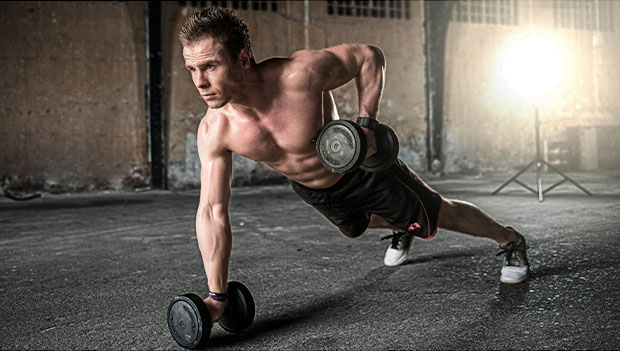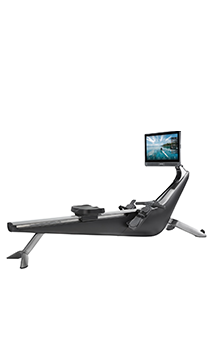
By clicking on the product links in this article, we may receive a commission fee at no cost to you, the reader. Sponsorships and affiliate commissions help support our research so we can help you find the best products. Read the full affiliate disclosure here.
As a 22-time Ironman Finisher who has also clocked a sub-2:30 marathon, endurance athlete, founder of multisport coaching service TriYon, and ACTIVE.com advisory board member Jamey Yon knows a little something about what it takes to be a successful runner.
One of the keystones to his coaching philosophy is the importance of balance. In fact, he believes that taking a total-body approach by incorporating strength training, proprioception, and less-impactful cardio exercises such as rowing is paramount to becoming a more well-rounded runner.
"Running is not forgiving," Yon said.
Here are some of Jamey Yon's tips on how to become a better runner by balancing out your regular training.
Start Weight Training
The high-impact nature of running puts a lot of stress on the bones, muscles, tendons, and ligaments of the legs. However, despite the painful pounding that runners endure, Yon stated that it can be a challenge to convince runners to add other exercises to their routine. This is especially true when it comes to weight training—the activity that the running coach picks as the most beneficial exercise that runners can do to become more well-rounded.
Yon said it is because runners fear getting "bulky" or adding weight because they believe that it will slow them down. This isn't necessarily true, though, and he can speak from firsthand experience.
"Weight is not bad. I ran my fastest marathon at my heaviest weight," Yon stated.
He also cited that retired professional runner Ryan Hall is an advocate for strength training. Hall, who holds the fastest marathon time by an American (2:04:58 - 2011 Boston Marathon), believes that the best way for runners to prevent and rehab injuries is weight training. In an article in Muscle & Fitness magazine, Hall is quoted as stating that when he started adding weights to his training regimen, he clocked greater sprint speeds and had more power.

While lower-body pump sessions may make sense, Yon stresses that upper-body strength should not be overlooked because it will create more efficiency in your running stride by improving your technique and allowing you to hold the correct posture longer. The coach further stated that runners need not fret about fitting hours of weight training into their schedule, nor do they need barbells and a bunch of bumper plates. He said that two to three 30-minute strength-training sessions per week (which can even be done with just resistance bands and body weight) are all runners need to see marked improvements.
Practice Proprioception
Considering that proprioception is often called "the sixth sense," it may seem that your sense of self-movement and body position is an innate ability. However, Yon says that not only can you have better proprioception, but that it is important to do so if you want to remain injury-free during your running training.
Through simply closing your eyes and practicing your balance or doing unweighted single-leg deadlifts you're "training your brain to fire" and "waking up your muscles." It also plays a crucial role in providing optimal posture control.
When you are fresh at the beginning of the run it is easy to have a strong, upright body. However, as the wear and tear of the miles start to add up, our bodies start to sag under the fatigue and we begin to waste energy. This makes our running less efficient and we become more prone to injury in these situations.
Incorporate Low-Impact Cardio Exercise
Running puts a lot of what is known as biomechanical stress on your body. Basically, this is stress to your bones, muscles, tendons, and ligaments caused by pounding our legs down on a hard surface and then absorbing the shock of that.
Since your lungs and heart don't know if you are running or doing another cardio activity, it is important to incorporate low-impact exercises such as rowing, cycling, or swimming into your running regimen. By doing so, you are still revving up your engine without causing too much wear or tear on your body.
Upgrade Your Nutrition and Gear
Yon also believes that proper nutrition and the right gear can help you become a better runner. Without proper nutrition, your body will not propel you forward efficiently.
For runs over one hour, or if you are running in high heat, an electrolyte beverage such as Fuel, Scratch, or Nuun are excellent options. He also advises you to grab yourself an on-the-go real-food snack such as Yon Bons, the protein endurance bites that Yon created for athletes.
One of the bonuses of running is that it doesn't take a lot of expensive equipment or gear. Here is the Yon-recommended list to have you starting out on the right foot:
- Running shoes: Get fitted at a run specialty shop and try on a few different brands before purchasing.
- Running socks: Thin, lightweight, non-cotton running socks are best.
- Sweat-wicking shorts and shirts: Look for lightweight materials that wick away sweat. Avoid cotton because it increases chafing risk.
- Bodyglide: Use an anti-chafing stick that can be applied before runs to keep your skin from rubbing.
- Running hat: Being exposed to direct sunlight can cause you to overheat much quicker.
- Hydration carrying system: Hydration is especially important for runs over one hour.
Although it may seem counterintuitive to run less to become a better, more well-rounded runner, it is necessary to add a variety of training disciplines into your running training. This will make you more powerful, more efficient, and less prone to injury.




